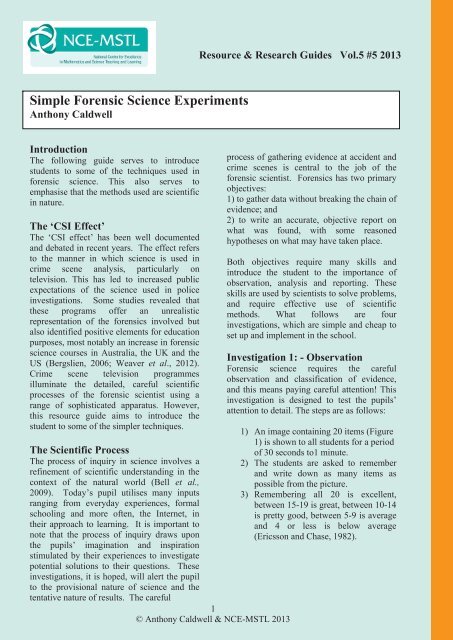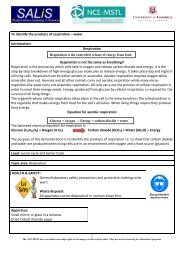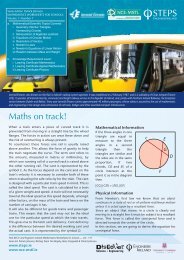Simple Forensic Science Experiments - NCE-MSTL
Simple Forensic Science Experiments - NCE-MSTL
Simple Forensic Science Experiments - NCE-MSTL
You also want an ePaper? Increase the reach of your titles
YUMPU automatically turns print PDFs into web optimized ePapers that Google loves.
Resource & Research Guides Vol.5 #5 2013<strong>Simple</strong> <strong>Forensic</strong> <strong>Science</strong> <strong>Experiments</strong>Anthony CaldwellIntroductionThe following guide serves to introducestudents to some of the techniques used inforensic science. This also serves toemphasise that the methods used are scientificin nature.The ‘CSI Effect’The ‘CSI effect’ has been well documentedand debated in recent years. The effect refersto the manner in which science is used incrime scene analysis, particularly ontelevision. This has led to increased publicexpectations of the science used in policeinvestigations. Some studies revealed thatthese programs offer an unrealisticrepresentation of the forensics involved butalso identified positive elements for educationpurposes, most notably an increase in forensicscience courses in Australia, the UK and theUS (Bergslien, 2006; Weaver et al., 2012).Crime scene television programmesilluminate the detailed, careful scientificprocesses of the forensic scientist using arange of sophisticated apparatus. However,this resource guide aims to introduce thestudent to some of the simpler techniques.The Scientific ProcessThe process of inquiry in science involves arefinement of scientific understanding in thecontext of the natural world (Bell et al.,2009). Today’s pupil utilises many inputsranging from everyday experiences, formalschooling and more often, the Internet, intheir approach to learning. It is important tonote that the process of inquiry draws uponthe pupils’ imagination and inspirationstimulated by their experiences to investigatepotential solutions to their questions. Theseinvestigations, it is hoped, will alert the pupilto the provisional nature of science and thetentative nature of results. The careful1© Anthony Caldwell & <strong>NCE</strong>-<strong>MSTL</strong> 2013process of gathering evidence at accident andcrime scenes is central to the job of theforensic scientist. <strong>Forensic</strong>s has two primaryobjectives:1) to gather data without breaking the chain ofevidence; and2) to write an accurate, objective report onwhat was found, with some reasonedhypotheses on what may have taken place.Both objectives require many skills andintroduce the student to the importance ofobservation, analysis and reporting. Theseskills are used by scientists to solve problems,and require effective use of scientificmethods. What follows are fourinvestigations, which are simple and cheap toset up and implement in the school.Investigation 1: - Observation<strong>Forensic</strong> science requires the carefulobservation and classification of evidence,and this means paying careful attention! Thisinvestigation is designed to test the pupils’attention to detail. The steps are as follows:1) An image containing 20 items (Figure1) is shown to all students for a periodof 30 seconds to1 minute.2) The students are asked to rememberand write down as many items aspossible from the picture.3) Remembering all 20 is excellent,between 15-19 is great, between 10-14is pretty good, between 5-9 is averageand 4 or less is below average(Ericsson and Chase, 1982).
Resource & Research Guides Vol.5 #5 2013Figure 1: 20 items memory test.Investigation 2: - FingerprintsFingerprints (dactylograms) and their uniquefeatures have been well documented and arefrequently used in crime scene and accidentinvestigations. The steps to taking fingerprintsare as follows:1) You’ll need an ink stamp, or someother ink that the student can use tocreate their own fingerprints.2) A small amount of ink is needed tocreate a clear fingerprint, but sincethey are small, a magnifying glassmay be needed to see relevantfeatures.3) Alternatively, the fingerprint isapplied to a partially blown up balloon(see Figure 2). Then, once the balloonis blown-up to full size, so too will thefingerprint, making it considerablyeasier to identify the distinguishingfeatures such as whorls, bifurcationsand arches.2© Anthony Caldwell & <strong>NCE</strong>-<strong>MSTL</strong> 2013Figure 2: Partially inflated balloon with fingerprinton the right, fully inflated balloon on the left.For more information on the balloonfingerprint investigation see the educatorsguide at ‘CSI Web Adventures’ athttp://forensics.rice.edu/en/materials/activity_ten.pdf.Investigation 3: – Blood SpatterWhile macabre, blood spatter analysis isincredibly interesting and many TV showsspend considerable time analysing bloodspatter, so that they can establish the eventswhich created the patterns. In this laboratorysimulation, the steps are as follows:1) First, you’ll need to make fake blood.To do this you’ll need red foodcolouring, water, syrup and flour(Figure 3).2) Combine one part water with threeparts syrup. Add a few drops of redfood colouring gradually and mixgently.3) Add as much flour as you need tothicken the mixture to achieve a closeapproximation to real blood.4) Let the mixture sit for ten minutes in awarm environment. This will give itsome time to thicken.5) Put the mixture into a simple washingup liquid bottle so that drops may bemade.6) Make drops of ‘blood’ fall onto awhite sheet of paper from differentheights, angles and onto different
Resource & Research Guides Vol.5 #5 2013materials to observe the effect(Figure 4).Fake blood is non-toxic but can be extremelymessy. It is recommended that aprons besupplied to students and ground rules aboutclean-up afterwards be made clearbeforehand. However, a word of warningwith this experiment!Most adults know how they feel about thesight of blood, be it real or fake. Check withyour group first that they don’t have apsychological issue with this, since it maytrigger queasiness or cause fainting spells.Figure 3: Blood spatter materials - flour, syrup, redfood dye and water.For more information on how to make fakeblood see ‘How to Make Fake Blood’ and tointerpret blood spatter see ‘InterpretingBloodstain Patterns’ at http://www.crimesceneforensics.com/Crime_Scene_<strong>Forensic</strong>s/Bloodstains.html.Investigation 4: – HandwritingAnalysisIn forensics, handwriting analysis is part ofthe analysis of questionable documents. Thebasis of handwriting analysis as a science isthe unique way each of us write. Documentexaminers typically analyse documents forsigns of alteration or forgery however, in thisinvestigation the focus is upon handwriting ortyping comparisons. This may be used todetermine or rule out who wrote certaindocuments (such as ransom demands) orconnect a document to a specific machine.1) Ask all students to write the samesentence with all letters of thealphabet for example, ‘The quickbrown fox jumped over the lazy dogs.’2) Show the students some examples offamous handwriting, e.g. BarackObama, Albert Einstein etc.3) Mix the samples up and hand themout.4) As a class experiment a ransomdemand could be made by one student.Could the class identify the student’shandwriting?Figure 4. Example of a bloodspatter pattern.Figure 4: A sample of handwriting.For more information on handwriting analysissee ‘The Secrets of / in Handwriting Analysis’at http://tammyswallow.hubpages.com/hub/The-3© Anthony Caldwell & <strong>NCE</strong>-<strong>MSTL</strong> 2013
Resource & Research Guides Vol.5 #5 2013Secrets-of-Hand-Writing-Analysis-What-You-Can-From-A-Persons-Writing-Style.SummaryIn order to provide rational explanations forany given phenomenon, asking questions andsuggesting explanations are essential. Earlywork in forensics by Edmund Locard led tothe development of the exchange principle,which stipulates that when someone enters anenvironment, they add something to andremove something from it (Chisum andTurvey, 2000). Collecting evidence such asfibres, DNA or fingerprints, has beenglamorised in many mainstream mediasources and as a result has contributed to therise in popularity in forensics course adoption.It is also important to encourage a criticaldiscussion about how forensics is handled innews and other media. The forensicspracticals suggested here are short, safe andcheap to set up, but the job of the forensicscientist is not for the faint-hearted. Exposureto crime scenes, accidents and the chain ofcausality that led to those events, may disturbsome but fascinate others. It is recommendedthat the focus be kept on science andmeasurement in the science laboratory butperhaps a discussion on ethics, criminologyand punishment be left for a civics lesson.Also, given the highly interactive nature ofthese experiments, there is considerable scopefor group work among students leading toboth, teacher-group and teacher-pupildiscussions regarding the limitations of thetests and what implications this may havefrom legal, ethical and scientific perspectives.ReferencesBalloon Fingerprint Activity. Available athttp://forensics.rice.edu/en/materials/activity_ten.pdf , retrieved 04/06/2013.Bell, P., Lewenstein, B., Shouse, A., W., Feder,M., A., (2009). Learning <strong>Science</strong> in InformalEnvironments: People, Places and Pursuits,National Research Council. ISBN 978-0-309-11955-9.Bergslien, E., (2006), ‘Teaching To Avoid the“CSI Effect” Keeping the <strong>Science</strong> in <strong>Forensic</strong><strong>Science</strong>’, Journal of Chemical Education, 83. (5),pp. 690-691.Chisum, W.J., Turvey, B., (2000). EvidenceDynamics: Locard's Exchange Principle & CrimeReconstruction. Journal of Behavioral Profiling,Vol. 1, No. 1 available athttp://www.profiling.org/journal/vol1_no1/jbp_ed_january2000_1-1.html, retrieved 18/10/2013.Ericsson, K., A Chase, W., G., (1982).Exceptional Memory: Extraordinary feats ofmemory can be matched or surpassed by peoplewith average memories that have been improvedby training. American Scientist, Vol. 70, No. 6,pp. 607-615. Available athttp://www.psy.cmu.edu/chasepapers/Exceptional%20Memory.pdf , retrieved 18/10/2013.How to Make Fake Blood. Available athttp://www.wikihow.com/Make-Fake-Blood,retrieved 04/06/2013.Interpreting Bloodstain Patterns. Available athttp://www.crimesceneforensics.com/Crime_Scene_<strong>Forensic</strong>s/Bloodstains.html, retrieved 04/06/2013.Scientific Method Applied to <strong>Forensic</strong> <strong>Science</strong>.Available athttp://marybernstein.wordpress.com/2009/05/27/scientific-method-applied-to-forensic-science/,retrieved 04/06/2013.The Secrets of / in Handwriting Analysis.Available athttp://tammyswallow.hubpages.com/hub/The-Secrets-of-Hand-Writing-Analysis-What-You-Can-From-A-Persons-Writing-Style, retrieved04/06/2013.Weaver, R., Salamonson, Y., Koch, J., Porter, G.,(2012), ‘’The CSI effect at university: forensicscience students' television viewing andperceptions of ethical issues, Australian Journalof <strong>Forensic</strong> <strong>Science</strong>s, 44 (4), pp. 381-391.Mr. Anthony CaldwellResearcher with the School of Educationat Queen’s University Belfast.E-mail: acaldwell02@qub.ac.uk4© Anthony Caldwell & <strong>NCE</strong>-<strong>MSTL</strong> 2013




